
The River Clyde is a river that flows into the Firth of Clyde, in the west of Scotland. It is the ninth-longest river in the United Kingdom, and the third longest in Scotland after the River Tay and the River Spey. It runs through the city of Glasgow. The River Clyde estuary has an upper tidal limit located at the tidal weir next to Glasgow Green.

The Firth of Clyde, is the estuary of the River Clyde, on the west coast of Scotland. The Firth has some of the deepest coastal waters of the British Isles. The Firth is sheltered from the Atlantic Ocean by the Kintyre Peninsula. The Firth lies between West Dunbartonshire in the north, Argyll and Bute in the west and Inverclyde, North Ayrshire and South Ayrshire in the east. The Kilbrannan Sound is a large arm of the Firth, separating the Kintyre Peninsula from the Isle of Arran. The Kyles of Bute separates the Isle of Bute from the Cowal Peninsula. The Sound of Bute separates the islands of Bute and Arran.

Partick is an area of Glasgow on the north bank of the River Clyde, just across from Govan. To the west lies Whiteinch, to the east Yorkhill and Kelvingrove Park, and to the north Broomhill, Hyndland, Dowanhill, Hillhead, areas which form part of the West End of Glasgow. Partick was a Police burgh from 1852 until 1912 when it was incorporated into the city. Partick is the area of the city most connected with the Highlands, and several Gaelic agencies, such as the Gaelic Books Council are located in the area. Some ATMs in the area display Gaelic.

Port Glasgow is the second-largest town in the Inverclyde council area of Scotland. The population according to the 1991 census for Port Glasgow was 19,426 persons and in the 2001 census was 16,617 persons. The most recent census in 2011 states that the population has declined to 15,414. It is located immediately to the east of Greenock and was previously a burgh in the county of Renfrewshire.
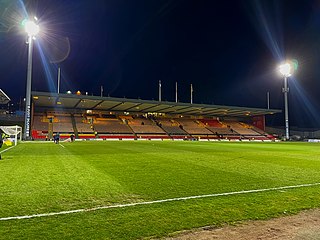
Firhill Stadium, also known as Wyre Stadium at Firhill for sponsorship reasons, is a football and former rugby union, rugby league and greyhound racing stadium located in the Maryhill area of Glasgow, Scotland which has been the home of Partick Thistle since 1909.

The Finnieston Crane or Stobcross Crane is a disused giant cantilever crane in the centre of Glasgow, Scotland. It is no longer operational, but is retained as a symbol of the city's engineering heritage. The crane was used for loading cargo, in particular steam locomotives, onto ships to be exported around the world.
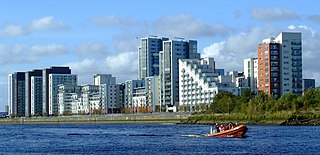
Glasgow Harbour is a private sector urban regeneration scheme at Partick in the West End of the city of Glasgow, Scotland. It is not the history and development of the wider and internationally famous Glasgow Harbour from Glasgow Green to Clydebank which developed from the early 1800s and witnessed the birth and growth of modern shipbuilding and shipping.
John Macgregor (1802–1858) was a Scottish shipbuilder.

The Peel Group is a British infrastructure and property investment business, based in Manchester. In 2022, its Peel Land and Property estate extends to 13 million square feet (1.2 km2) of buildings, and over 33,000 acres (13,000 ha) of land and water. Peel retains minority stakes in its former ports business and MediaCityUK.

The Glasgow Garden Festival was the third of the five national garden festivals, and the only one to take place in Scotland.

Pacific Quay is an area south of the River Clyde in Glasgow, Scotland. It is located at the former Plantation Quay and Princes' Dock Basin. The Princes' Dock Basin was the largest on the River Clyde when it was opened by the Clyde Navigation Trust in 1900. It ceased to be used as a commercial dock by the Clyde Port Authority in the 1970s as the volume of Shipping using the Upper Clyde declined with the onset of containerization. The site was later used for the Glasgow Garden Festival in 1988. The former electric generating station and pumping house, "Four Winds" which was used to pump water between the rotundas and generate power for the electric cranes still stands and is now home to a consultant engineers and radio station. The name 'Pacific Quay' has no historical significance, as it was created simply as a marketing enterprise following the land being reclaimed for commercial use after the Garden Festival closure. It did not reflect the site as a departure point for ships bound for the Pacific Rim.

Partick West railway station was a station that served the Partick area of the city of Glasgow, particularly the Thornwood section of Partick from 1896 to 1964. It was a four platform station on the Lanarkshire and Dunbartonshire Railway, with two platforms on an east–west line with services between Dumbarton and Glasgow city centre and a further two platforms on a north–south line with services between Maryhill and the city centre.
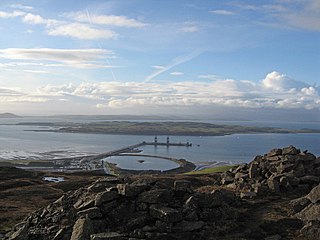
Hunterston Terminal, in North Ayrshire, Scotland, was an iron ore and coal-handling port located at Fairlie on the Firth of Clyde, operated by Clydeport which was taken over by The Peel Group in 2003. It lies south of Fairlie, adjacent to Hunterston estate, site of Hunterston Castle, and its jetty projects out approximately 1 mile (1.6 km), about midway into the channel between the mainland and the island of Great Cumbrae.
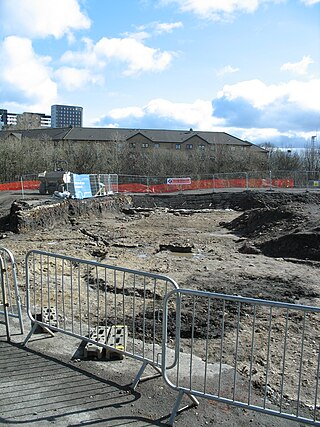
Partick Castle was located in Partick, now a Western suburb of Glasgow. It was built in 1611 for the Glasgow benefactor George Hutcheson and situated on the west bank of the River Kelvin.
This article deals with the history of the Partick area of Glasgow in Scotland.

Port Dundas is an area of Glasgow, Scotland, located 1 mile (1.6 km) to the north of the city centre. It lies to the north of Cowcaddens, and to the west of Sighthill, with Hamiltonhill and Possilpark to the north-west.
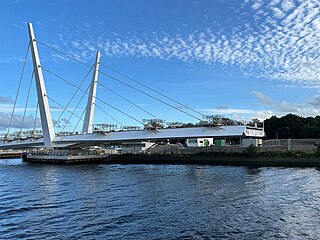
The New River Clyde bridge is a current construction as part of the ongoing Clyde Waterfront Regeneration. Scheduled for completion in late 2024, it will be the first new vehicle crossing point on the Clyde since the Clyde Arc bridge was built in 2006.
Meadowside was a football ground in the Partick area of Glasgow, Scotland. It was the home ground of Partick Thistle from 1897 until 1908.
Daniel Miller (1825–1888) was a 19th-century Scottish civil engineer and inventor remembered as a harbour and bridge-builder.
Inchview was a football ground in the Whiteinch area of Glasgow, Scotland. It was the home ground of Partick from the 1870s until 1885, and of Partick Thistle from 1885 until 1897.
















